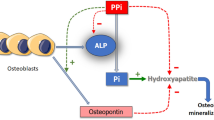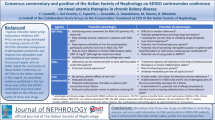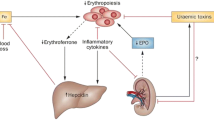Abstract
Recently, we have shown that erythrocytes obtained from patients with chronic renal failure (CRF) exhibited an increased rate of ATP formation from adenine as a substrate. Thus, we concluded that this process was in part responsible for the increase of adenine nucleotide concentration in uremic erythrocytes. There cannot be excluded however, that a decreased rate of adenylate degradation is an additional mechanism responsible for the elevated ATP concentration. To test this hypothesis, in this paper we compared the rate of adenine nucleotide breakdown in the erythrocytes obtained from patients with CRF and from healthy subjects.
Using HPLC technique, we evaluated: (1) hypoxanthine production by uremic RBC incubated in incubation medium: (a) pH 7.4 containing 1.2 mM phosphate (which mimics physiological conditions) and (b) pH 7.1 containing 2.4 mM phosphate (which mimics uremic conditions); (2) adenine nucleotide degradation (IMP, inosine, adenosine, hypoxanthine production) by uremic RBC incubated in the presence of iodoacetate (glycolysis inhibitor) and EHNA (adenosine deaminase inhibitor). The erythrocytes of healthy volunteers served as control.
The obtained results indicate that adenine nucleotide catabolism measured as a hypoxanthine formation was much faster in erythrocytes of patients with CRF than in the cells of healthy subjects. This phenomenon was observed both in the erythrocytes incubated at pH 7.4 in the medium containing 1.2 mM inorganic phosphate and in the medium which mimics hyperphosphatemia (2.4 mM) and metabolic acidosis (pH 7.1). The experiments with EHNA indicated that adenine nucleotide degradation proceeded via AMP-IMP-Inosine-Hypoxanthine pathway in erythrocytes of both patients with CRF and healthy subjects. Iodoacetate caused a several fold stimulation of adenylate breakdown. Under these conditions: (a) the rate of AMP catabolites (IMP + inosine + adenosine + hypoxanthine) formation was substantially higher in the erythrocytes from patients with CRF; (b) in erythrocytes of healthy subjects degradation of AMP proceeded via IMP and via adenosine essentially at the same rate; (c) in erythrocytes of patients with CRF the rate of AMP degradation via IMP was about 2 fold greater than via adenosine.
The results presented in this paper suggest that adenine nucleotide degradation is markedly accelerated in erythrocytes of patients with CRF.
Similar content being viewed by others
References
Hurt GA, Chanutin A: Organic phosphate compounds of erythrocytes from individuals with uremia. J Lab Clin Med 64: 675-684, 1964
Lichtman MA, Miller DR: Erythrocyte glycolysis, 2,3-diphosphoglycerate and adenosine triphosphate concentration in uremic subjects: Relationship to extracellular phosphate concentration. J Lab Clin Med 76: 267-279, 1970
Lichtman MA, Murphy MS: Red cell adenosine triphosphate in hipoproliferative anemia with and without chronic renal disease: Relationship to hemoglobin deficit and plasma inorganic phosphate. Blood Cells 1: 467-484, 1975
Wallas CH: Metabolic studies on the erythrocyte from patients with chronic renal disease on haemodialysis. II. ATP metabolism. Br J Haem 27: 145-152, 1974
Mansell MA, Grimes AJ: Red and white cell abnormalities in chronic renal failure. Br J Haem 42: 169-174, 1979
Marlewski M, Smolenski RT, Szolkiewicz M, Aleksandrowicz Z, Rutkowski B, Swierczynski J: Increased rate of adenine incorporation into adenine nucleotide pool in erythrocytes of patients with chronic renal failure. Nephron: (in press)
Bontemps F, Van den Berghe G, Hers HG: Pathways of adenine nucleotide catabolism in erythrocytes. J Clin Invest 77: 824-830, 1986
Berman PA, Black DA, Human L, Harley EH: Oxipurine cycle in human erythrocytes regulated by pH, inorganic phosphate and oxygen. J Clin Invest 82: 980-986, 1988
Berman PA, Human L: Regulation of 5-phosphorybosyl 1-pyrophosphate and of hypoxanthine uptake and release in human erythrocytes by oxypurine cycling. J Biol Chem 265: 6562-6568, 1990
Stone TW, Simmonds HA: Tissue specifity of purine metabolism. In: T.W. Stone, H.A. Simmonds (eds). Purines: Basic and Clinical Aspects. Kluwer Academic Publishers, 1991, p 23
Smolenski RT, Lachno DR, Ledingham SJM, Yacoub MH: Determination of sixteen nucleotides, nucleosides and bases using high-performance liquid chromatography and its application to the study of purine metabolism in hearts for transplantation. J Chromatogr 527: 414-420, 1990
Smolenski RT, Montero C, Rodgers AV, Simmonds HA: A high performance liquid chromatographic assay for AMP-deaminase activity in the erythrocytes of healthy subject and patients with inherited purine disorders. Biomed Chromatogr 5: 171-174, 1990
Yun S, Suelter CH: Human erythrocyte 5′-AMP aminohydrolase. J Biol Chem 253: 404-408, 1978
Wallas CH: Metabolic studies on red cells from patients with chronic renal disease on haemodialysis. Br J Haem 26: 71-78, 1974
Author information
Authors and Affiliations
Rights and permissions
About this article
Cite this article
Marlewski, M., Smolenski, R.T., Szolkiewicz, M. et al. Accelerated degradation of adenine nucleotide in erythrocytes of patients with chronic renal failure. Mol Cell Biochem 213, 93–97 (2000). https://doi.org/10.1023/A:1007164114840
Issue Date:
DOI: https://doi.org/10.1023/A:1007164114840




